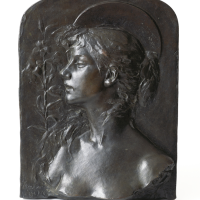13. BERTRAM MACKENNAL

Bertram Mackennal is highly regarded today as one of Australias most successful modern sculptors. A key exponent of the New Sculpture movement that transformed English sculpture in the late 19th century, his versatile output shows that he was equally at home working on intimate and domestic works, such as La tte dune sainte (Head of a saint), 1892, as with larger-than-life sculptures commissioned expressly for the public domain.
Bertram Mackennals works combine a sensitivity of touch with a sound knowledge of human anatomy and form. His aim was to convey heightened emotive states by carving in marble or modelling and casting in plaster, clay and bronze. Ultimately, he aimed to fuse elements of the spiritual with the corporeal. Subtly delineated bronze surfaces that speak of the interior motivations of the figures are favoured over realism or verisimilitude for its own sake. In this way Mackennals work reveals a knowledge of the pioneering modern sculptor Auguste Rodin, whom he knew personally. Rodin led the new-found interest in the expressive potential of the human face and body and initiated contemporary debate concerning the nude and naturalism in art. Significantly, Mackennal was also at the vanguard of the emergence of French and British Symbolist painters, sculptors and authors. These artists aimed to transform contemporary attitudes towards women by foregrounding the suggestive and the profane.
La tte dune sainte (Head of a saint), 1892, is one of the first works Mackennal produced when he was resident in Paris during 1892-94. He had recently returned to Europe where he was producing acclaimed French diva Sarah Bernhardts relief portrait in bronze, at her invitation. The two had become good friends during Bernhardts 1891 Australian tour. She is credited with advising him to return to Paris to escape being buried alive.
There are some striking visual similarities between Sarah Bernhardt, c.1892-c.1893 (in the collection of Art Gallery of New South Wales) and Head of a saint. Foremost amongst these is the inspiration taken from quattrocento Italian sculpture; in particular, the work of Florentine Donatello (c.1386-1466) as well as and sculptural reliefs by his contemporary Agostino di Duccio (1418-c.1481).The ability of both artists to articulate a refined and elegant naturalism from shallow relief (schiavo) is a feature of Mackennals work also.
Head of a saint includes traditional religious subject matter including a halo and white lily. Despite this, Mackennal treats both religious and secular subjects in a very contemporary way as curator Deborah Edwards succinctly put it: the subject [in Head of a saint] is a contemporary modern woman, her swirling tendrils of hair and the elaborate lilies signalling an art-nouveau organicism that vitalises the composition, which becomes molten in bronze form.2 The two works by Mackennal are variations on the theme of the power and mystery of women and the idea of a fluid indefinable female identity. The theme of the New Woman or alternatively the more dangerous femme fatale were pervasive in Symbolist art at the time, where artists strived to convey a realm beyond the material or visible world. The divine Sarah would have appreciated being seen in such a light!
Bertram Mackennal often cast in bronze his most successful marble sculptures. The accolades given to the marble version of Head of a saint when it was included, along with a second relief work by Mackennal, in the prestigious Paris Salon of 1892 would have no doubt influenced his decision to make the bronze. As a correspondent to the Argus duly noted: the relief in marble, for its size, is the best thing of its kind in the Salon.2 La tte dune sainte (Head of a saint), 1892, is the only known edition of this work and represents a rare expression of Mackennals art at the commencement of his most successful period.
Footnotes:
1. Edwards, D., Bertram Mackennal, Art Gallery of New South Wales, Sydney, 2007, p.52.
2. The Australian artists in Paris, The Argus, 17 August 1892, p.6.
Rodney James BA (Hons); MA